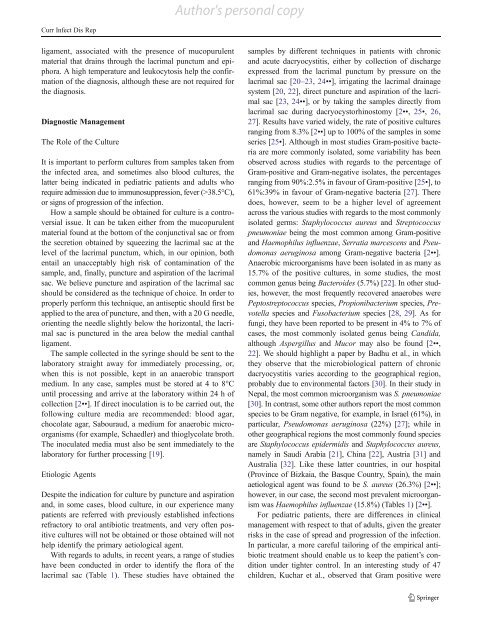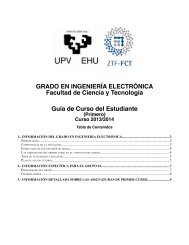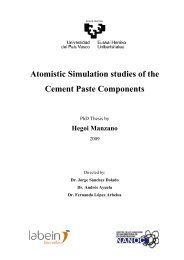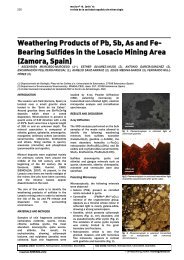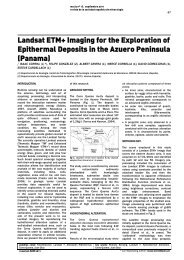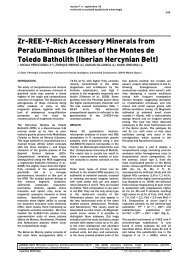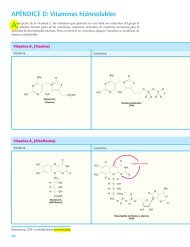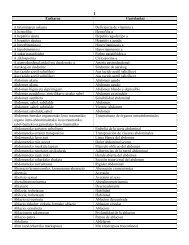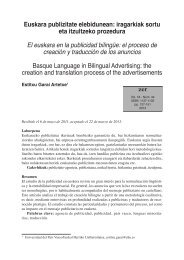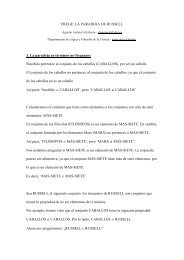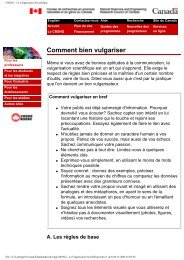Dacryocystitis: Systematic Approach to Diagnosis and Therapy ...
Dacryocystitis: Systematic Approach to Diagnosis and Therapy ...
Dacryocystitis: Systematic Approach to Diagnosis and Therapy ...
You also want an ePaper? Increase the reach of your titles
YUMPU automatically turns print PDFs into web optimized ePapers that Google loves.
Author's personal copy<br />
Curr Infect Dis Rep<br />
ligament, associated with the presence of mucopurulent<br />
material that drains through the lacrimal punctum <strong>and</strong> epiphora.<br />
A high temperature <strong>and</strong> leukocy<strong>to</strong>sis help the confirmation<br />
of the diagnosis, although these are not required for<br />
the diagnosis.<br />
Diagnostic Management<br />
The Role of the Culture<br />
It is important <strong>to</strong> perform cultures from samples taken from<br />
the infected area, <strong>and</strong> sometimes also blood cultures, the<br />
latter being indicated in pediatric patients <strong>and</strong> adults who<br />
require admission due <strong>to</strong> immunosuppression, fever (>38.5°C),<br />
or signs of progression of the infection.<br />
How a sample should be obtained for culture is a controversial<br />
issue. It can be taken either from the mucopurulent<br />
material found at the bot<strong>to</strong>m of the conjunctival sac or from<br />
the secretion obtained by squeezing the lacrimal sac at the<br />
level of the lacrimal punctum, which, in our opinion, both<br />
entail an unacceptably high risk of contamination of the<br />
sample, <strong>and</strong>, finally, puncture <strong>and</strong> aspiration of the lacrimal<br />
sac. We believe puncture <strong>and</strong> aspiration of the lacrimal sac<br />
should be considered as the technique of choice. In order <strong>to</strong><br />
properly perform this technique, an antiseptic should first be<br />
applied <strong>to</strong> the area of puncture, <strong>and</strong> then, with a 20 G needle,<br />
orienting the needle slightly below the horizontal, the lacrimal<br />
sac is punctured in the area below the medial canthal<br />
ligament.<br />
The sample collected in the syringe should be sent <strong>to</strong> the<br />
labora<strong>to</strong>ry straight away for immediately processing, or,<br />
when this is not possible, kept in an anaerobic transport<br />
medium. In any case, samples must be s<strong>to</strong>red at 4 <strong>to</strong> 8°C<br />
until processing <strong>and</strong> arrive at the labora<strong>to</strong>ry within 24 h of<br />
collection [2••]. If direct inoculation is <strong>to</strong> be carried out, the<br />
following culture media are recommended: blood agar,<br />
chocolate agar, Sabouraud, a medium for anaerobic microorganisms<br />
(for example, Schaedler) <strong>and</strong> thioglycolate broth.<br />
The inoculated media must also be sent immediately <strong>to</strong> the<br />
labora<strong>to</strong>ry for further processing [19].<br />
Etiologic Agents<br />
Despite the indication for culture by puncture <strong>and</strong> aspiration<br />
<strong>and</strong>, in some cases, blood culture, in our experience many<br />
patients are referred with previously established infections<br />
refrac<strong>to</strong>ry <strong>to</strong> oral antibiotic treatments, <strong>and</strong> very often positive<br />
cultures will not be obtained or those obtained will not<br />
help identify the primary aetiological agent.<br />
With regards <strong>to</strong> adults, in recent years, a range of studies<br />
have been conducted in order <strong>to</strong> identify the flora of the<br />
lacrimal sac (Table 1). These studies have obtained the<br />
samples by different techniques in patients with chronic<br />
<strong>and</strong> acute dacryocystitis, either by collection of discharge<br />
expressed from the lacrimal punctum by pressure on the<br />
lacrimal sac [20–23, 24••], irrigating the lacrimal drainage<br />
system [20, 22], direct puncture <strong>and</strong> aspiration of the lacrimal<br />
sac [23, 24••], or by taking the samples directly from<br />
lacrimal sac during dacryocys<strong>to</strong>rhinos<strong>to</strong>my [2••, 25•, 26,<br />
27]. Results have varied widely, the rate of positive cultures<br />
ranging from 8.3% [2••] up <strong>to</strong> 100% of the samples in some<br />
series [25•]. Although in most studies Gram-positive bacteria<br />
are more commonly isolated, some variability has been<br />
observed across studies with regards <strong>to</strong> the percentage of<br />
Gram-positive <strong>and</strong> Gram-negative isolates, the percentages<br />
ranging from 90%:2.5% in favour of Gram-positive [25•], <strong>to</strong><br />
61%:39% in favour of Gram-negative bacteria [27]. There<br />
does, however, seem <strong>to</strong> be a higher level of agreement<br />
across the various studies with regards <strong>to</strong> the most commonly<br />
isolated germs: Staphylococcus aureus <strong>and</strong> Strep<strong>to</strong>coccus<br />
pneumoniae being the most common among Gram-positive<br />
<strong>and</strong> Haemophilus influenzae, Serratia marcescens <strong>and</strong> Pseudomonas<br />
aeruginosa among Gram-negative bacteria [2••].<br />
Anaerobic microorganisms have been isolated in as many as<br />
15.7% of the positive cultures, in some studies, the most<br />
common genus being Bacteroides (5.7%) [22]. In other studies,<br />
however, the most frequently recovered anaerobes were<br />
Pep<strong>to</strong>strep<strong>to</strong>coccus species, Propionibacterium species, Prevotella<br />
species <strong>and</strong> Fusobacterium species [28, 29]. As for<br />
fungi, they have been reported <strong>to</strong> be present in 4% <strong>to</strong> 7% of<br />
cases, the most commonly isolated genus being C<strong>and</strong>ida,<br />
although Aspergillus <strong>and</strong> Mucor may also be found [2••,<br />
22]. We should highlight a paper by Badhu et al., in which<br />
they observe that the microbiological pattern of chronic<br />
dacryocystitis varies according <strong>to</strong> the geographical region,<br />
probably due <strong>to</strong> environmental fac<strong>to</strong>rs [30]. In their study in<br />
Nepal, the most common microorganism was S. pneumoniae<br />
[30]. In contrast, some other authors report the most common<br />
species <strong>to</strong> be Gram negative, for example, in Israel (61%), in<br />
particular, Pseudomonas aeruginosa (22%) [27]; while in<br />
other geographical regions the most commonly found species<br />
are Staphylococcus epidermidis <strong>and</strong> Staphylococcus aureus,<br />
namely in Saudi Arabia [21], China [22], Austria [31] <strong>and</strong><br />
Australia [32]. Like these latter countries, in our hospital<br />
(Province of Bizkaia, the Basque Country, Spain), the main<br />
aetiological agent was found <strong>to</strong> be S. aureus (26.3%) [2••];<br />
however, in our case, the second most prevalent microorganism<br />
was Haemophilus influenzae (15.8%) (Tables 1) [2••].<br />
For pediatric patients, there are differences in clinical<br />
management with respect <strong>to</strong> that of adults, given the greater<br />
risks in the case of spread <strong>and</strong> progression of the infection.<br />
In particular, a more careful tailoring of the empirical antibiotic<br />
treatment should enable us <strong>to</strong> keep the patient’s condition<br />
under tighter control. In an interesting study of 47<br />
children, Kuchar et al., observed that Gram positive were


